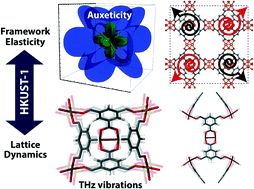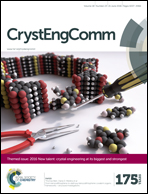Discovering connections between terahertz vibrations and elasticity underpinning the collective dynamics of the HKUST-1 metal–organic framework†
Abstract
We employed a combination of theoretical and experimental techniques to study the metal–organic framework (MOF)-mechanics central to the paddle-wheel Cu3(BTC)2 porous structure, commonly designated as HKUST-1. Lattice dynamics of the hybrid framework at below 18 THz were measured by means of Raman and synchrotron far-infrared spectroscopy, and systematically correlated to collective vibrational modes computed from ab initio density functional theory (DFT). We have identified a number of intriguing low-energy framework vibration mechanisms, reminiscent of the ‘trampoline-like’ deformations and new oscillatory motions associated with Cu paddle-wheel ‘molecular rotors’. The three independent single-crystal elastic constants of the HKUST-1 (i.e. C11, C12 and C44) were calculated using the DFT approach, taking into account the effects of dispersion corrections. We established the full elasticity solutions accompanying detailed deformation mechanisms that control its anisotropic mechanical properties, ranging from the Young's and shear moduli to linear compressibility and Poisson's ratio. Our results support the notion that the co-existance of soft modes and intrinsic shear distortions connected to the THz lattice dynamics dictate a range of anomalous elastic phenomena, for example: negative Poisson's ratio (auxeticity), negative thermal expansion (NTE), and exceedingly low shear moduli properties.

- This article is part of the themed collection: 2016 New talent

 Please wait while we load your content...
Please wait while we load your content...